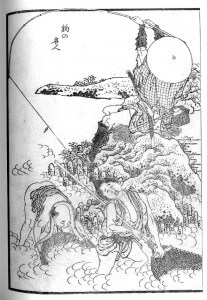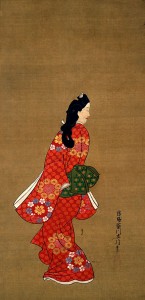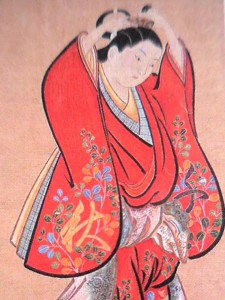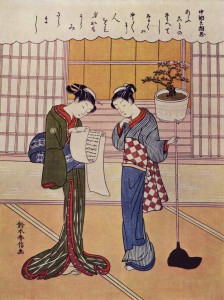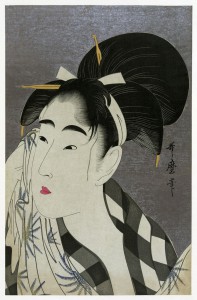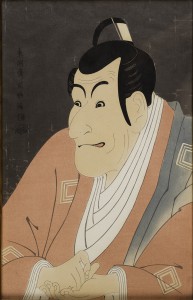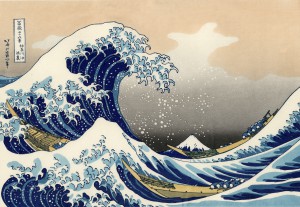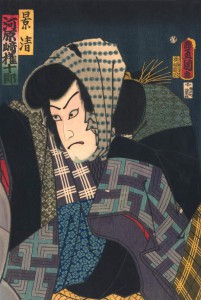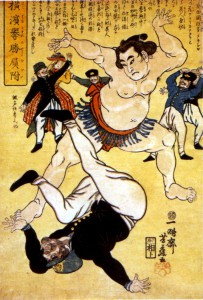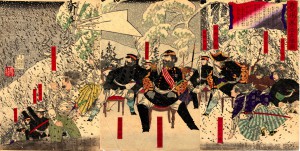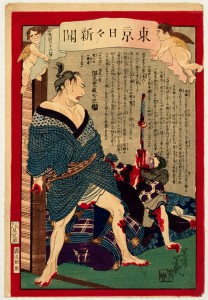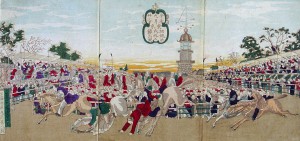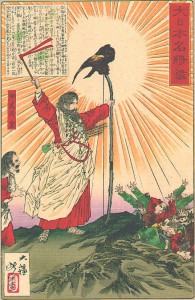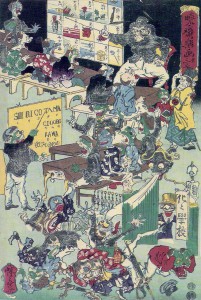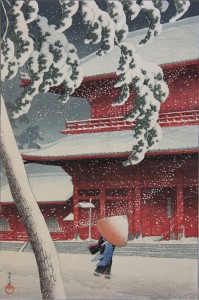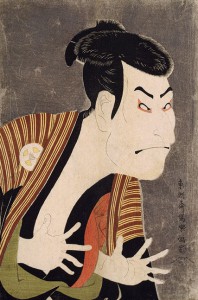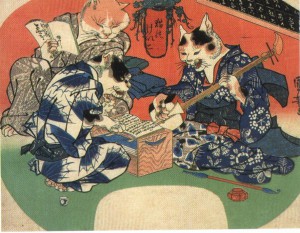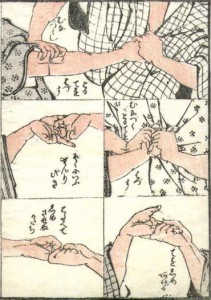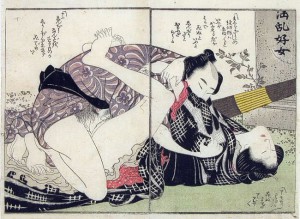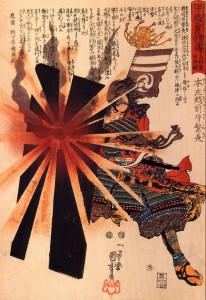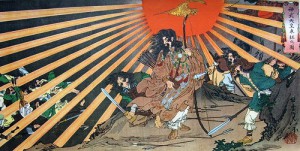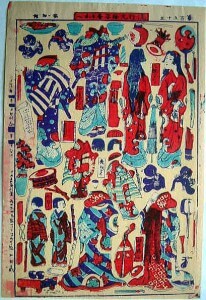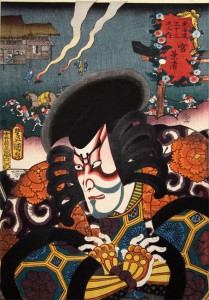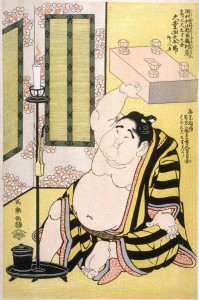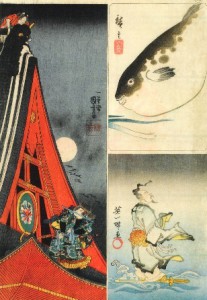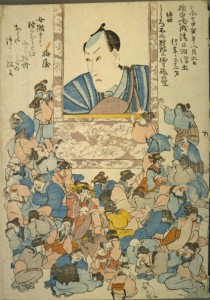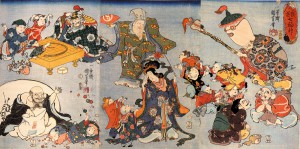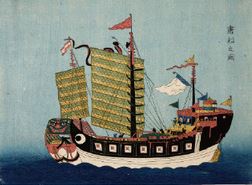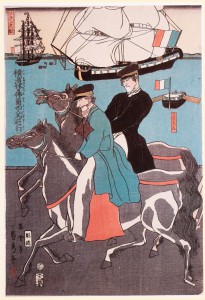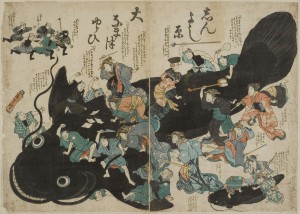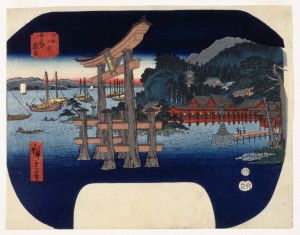Ukiyo-e
Contents
- 1 Ukiyo-e is the most famous Japanese art.
- 2 Summary
- 3 History
- 4 Subject Matter | Types of Ukiyo-e
- 4.1 Bijin-ga:
- 4.2 Yakusha-e:
- 4.3 Caricature:
- 4.4 Toba-e:
- 4.5 Comics:
- 4.6 Shun-ga:
- 4.7 Meisho-e (Ukiyo-e prints of landscapes):
- 4.8 Musha-e:
- 4.9 Rekishi-ga:
- 4.10 Omocha-e:
- 4.11 Mitate-e:
- 4.12 Sumou-e:
- 4.13 Harimaze-e:
- 4.14 Shini-e:
- 4.15 Kodomo-e:
- 4.16 Nagasaki-e:
- 4.17 Yokohama-e:
- 4.18 Namazu-e:
- 4.19 Housou-e:
- 4.20 Uchiwa-e:
- 5 Production Process
- 6 Reputation and Influence
- 7 Influence from Overseas
- 8 Impact on Foreign Countries
Ukiyo-e is the most famous Japanese art.
Ukiyo-e is a genre of the pictorial arts that originated during the Edo period. Generally, when it comes to Ukiyo-e today, one thinks of is solely reminded of the multicolor woodblock print (Nishikie [colored woodblock print]), but original drawings (Nikuhitsu Ukiyo-e [single copy paintings created by brush]) and so on are also included. The word “ukiyo” (this life) also means “modern,” and Ukiyo-e refers to Fuuzoku-ga, in which paintings depicts the manners and customs of the day. While Ukiyo-e is descended from Yamato-e painting (a traditional Japanese style painting of the late Heian and Kamakura periods dealing with Japanese themes), and consistent with the cultural background of the comprehensive pictorial art genre; by contrast, it depicts scenes from people’s everyday life and local sites and customs.
Summary
Ukiyo-e is divided into two categories: the original drawing and the woodblock print. An original drawing was created as a single piece of work, and drawings of prestigious Eshi painters were expensive, and also the numbers of works were limited. Contrastingly, the woodblock print benefited from the fact that as a print, the same picture could be inexpensively printed off many times, so even the general public of the Edo period was easily able to obtain such works.
The Ukiyo-e woodblock print was a part of the popular culture, and prints were appreciated by being picked up and looked at. They were not framed and viewed from a distance, in the way that we experience them today at art exhibitions, etc. They served as illustrations for Kusazoushi (Japanese chapter books), Emakimono (illustrated scrolls) and Kawaraban (commercial news sheets of the Edo period). Picture calendars called Egoyomi, which included works with diverse ideas, such as having hidden numbers in the pictures, were produced. As souvenirs from Edo, Ukiyo-e were appreciated due to their beauty and small size. There was a type used for clipping play, like Omocha-e (toy pictures for children).
Ukiyo-e is, in terms of expressiveness, characterized by clear-cut design, daring patterns, shadowless expression, etc. Perspective was also introduced. There was a type in which perspective was intentionally ignored, as demonstrated in Hokusai’s “Tsuri no meijin” (Master of fishing), where a figure in the distance is conversely depicted as larger.
History
Ukiyo-e originally appeared as paintings depicting the customs and manners of everyday life, ‘ukiyo.’ Many painters from the Kanou School and the Tosa School also painted Ukiyo-e.
The Begining Period
From the Great Fire in Meireki to around the Houreki era. There appeared Tan-e and Beni-e, which colored Sumizuri-e with red pigment; there was also Benizuri-e, in which adding few additional colors, such as green on Beni-e. Immediately before the appearance of Nishiki-e, an extremely low-chromatic multicolor printing called Mizu-e emerged, in which profile lines are drawn by “Tsuyukusa” (blue Asiatic Dayflower) rather than India ink.
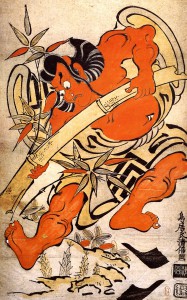
Tan-e / Artist: Kiyomasu Torii / Title: Kabuki actor Ichikawa Danjuurou I in the role of Takenuki Gorou
Details
After the mid-17th century, a person who made original drawings for woodblock prints was called Hanshita-eshi (professional draftsman), then Moronobu Hishikawa, who drew illustrations for picture books and Ukiyo-zoushi (popular stories of everyday life in the Edo period), made his appearance. The famous “Mikaeri Bijin zu (Picture of Looking-Back Beauty),” his most important work, is an original drawing. Saikaku‘s “Kosuhoku ichidai otoko (Life of a Amorous Man)” (published in 1682) describes that Ukiyo-e was drawn on a folding fan with 12 ribs, and this is the oldest literature in which the word “Ukiyo-e” can be found. When the days of Kiyonobu Torii began, there appeared a type of Sumizuri-e colored with ink brush. These were colored mainly with red pigments, but one with tan (red earth) being used was called Tan-e and the one with beni (rouge) used was called Beni-e. Furthermore, one with a few colors being added to Beni-e was called Benizuri-e. Since that time, the Torii school of Ukiyo-e has closely been associated with Kabuki (traditional drama performed by male actors) and works on Kabuki billboards even today.
The Middle Period
From 1765 to around 1806. A form of bright multicolor printing, Azuma-nishiki-e (brocade picture of the East) was devised, and it brought the Ukiyo-e culture into bloom. The division of labor was beginning to be established among Shitae-shi (Ukiyo-e artists), Hori-shi (carvers) and Suri-shi (printers).
Details
This refers to the period from 1765, when Nishiki-e (print) was born, to around 1806. In 1765, Egoyomi (picture calendars) became fashionable, especially among Haiku poets, and Egoyomi exchange parties started to be organized. To meet the demand, Harunobu Suzuki and others worked out Azuma-nishiki-e printed in multiple colors, and the Ukiyo-e culture came into full bloom. As to the factors by which multicolor printing was made possible, it is pointed out that “Kentou” (guide marks) were introduced to mark the points for overprinting, and that strong, high-quality Japanese paper that withstood multiple-color printing became available. Paper made of Kouzo (paper mulberry), such as Echizen-houshogami (heavy Japanese paper of the best quality in Echizen Province), Iyo-masagami, Nishino-uchigami and so on were used. Also, the economic development took an important role, as the division of labor was established for the complicated processes among Shitae-shi, Hori-shi and Suri-shi.
After Harunobu Suzuki’s death, Bijin-ga began to change from androgynous, doll-like patterns to realistic ones.
During the An-ei era, Shigemasa Kitao enjoyed popularity for his Bijin-ga. Realistic delineation was also added to Yakusha-e, and bromide-like Nigao-e (portraits) were drawn by Shunshou Katsukawa.
Furthermore, Utamaro Kitagawa made his appearance and drew many Ookubi-e (“large-head” pictures), which was a type of Bijin-ga with a delicate, elegant, gracious touch.
In 1790, the ‘Aratame in’ approval seal system was established, and various restrictions were enforced for publications.
In 1795, a Hanmoto (publisher) called Juuzaburou Tsutaya, whose assets had been confiscated due to his breaking a ban, introduced Sharaku Toushuusai as a revival measure. Though he attracted public attention with his uniquely exaggerated Yakusha-e, his popularity made a poor showing due to the excessive exaggeration of features, and he was defeated by “Yakusha butai no sugatae” (likenesses of actors on the stage) by Toyokuni Utagawa, which were overwhelmingly popular.
Afterward, the largest school of Ukiyo-e Eshi painters, the Utagawa school, consisting of Toyokuni’s disciples began to take shape.
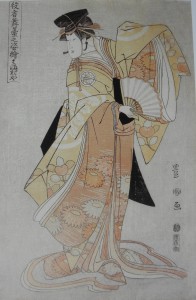
Artist: Toyokuni Utagawa / Title: The Actor Kikunojou Segawa III as Shirabyoushi Dancer Hisakata, Series “Pictures of Actors on Stage“
The Latter Period
From 1807 to around 1858. Bijin-ga (a type of Ukiyo-e portraying beautiful women), Yakusha-e (print of Kabuki actors), Musha-e (Ukiyo-e prints of warriors) and Meisho-e (landscape drawings), as a result of travel boom, were developed.
Details
After the Bunka-Bunsei period, Bijin-ga of a decadent style such as those drawn by Eisen Keisai, which are of sadistic taste and represented perverse pathos, became popular.
Hokusai Katsushika, one of Shunshou Katsukawa’s disciples, along with the travel boom, drew the “Fugaku sanjuu rokkei (Thirty-Six Views of Mount Fuji),” which triggered the publication of the “Toukaidou Gojuusan-tsugi (The Fifty-Three Stations of the Toukaidou Road),” by Hiroshige Utagawa. With these two artists, Meisho-e (landscape drawing) in the category of Ukiyo-e was developed.
In the category of Yakusha-e, Kunisada Utagawa, as the successor to his teacher Toyokuni Utagawa, drew strong Yakusha-e.
In Kusazoushi, Musha-e, along with the boom in fantastical tales, came to be drawn by Kuniyoshi Utagawa and others. The “Suikoden” (The Water Margin) series of Kuniyoshi Utagawa gained popularity at that time, and the “Suikoden boom” took place.
“Edo sunako saisenki” published in 1853 described “Toyokuni Nigao (Nigao-e), Kuniyoshi Musha (Musha-e) and Hiroshige Meisho (Meisho-e).”

Artist: Keisen Eisai / Title: Beautiful Woman
The End Period
From 1859 to around 1912. From the end of the Edo period to the Meiji period, such Ukiyo-e as Yokohama-e (Yokohama pictures), Kaika-e (enlightenment pictures), Nishiki-e-shinbun (newspapers) and so on played an important role in introducing Western things as well as Japanese society. Muzan-e (atrocity prints) and Sensou-e (prints of war, or battle scenes), were well received, but Ukiyo-e eventually began to decline, losing ground to other media such as newspapers, photographs, etc. Eshi painters changed careers and became illustrators and Japanese-style painters, and the tradition of Ukiyo-e came down to other genres.
Details
Yokohama-e (Yokohama Ukiyo-e) became fashionable among people who were inspired by Kurofune (the “black ships” of Commodore Matthew Perry) and became interested in Western cultures. After the Meiji Restoration, Kaika-e (enlightenment pictures), which depict rare Western architecture and railways, replaced Yokohama-e.
While in Japan which was domestically disrupted by the Meiji Restoration, grotesque things appeared in Kabuki and other shows, Yoshiiku Ochiai and Yoshitoshi Tsukioka, who were disciples of Kuniyoshi Utagawa, drew “Eimei nijuuhasshuuku,” which depicted bloody scenes and were called Muzan-e, as well as illustrations for articles in Nishikie-shinbun.
Yoshitoshi Tsukioka, with his delicate, sketching-oriented patterns, drew not only Muzan-e but also many Rekishi-ga (historical paintings) and Fuuzoku-ga, and came to be called “The last Ukiyo-e artist.” As he positively encouraged his disciples to learn about other categories of the pictorial art, many disciples achieved greatness as illustrators and Japanese-style painters, such as Kiyokata Kaburaki; thus the tradition of Ukiyo-e came down to other genres.
Also, some artists of the Kanou school, including Kyousai Kawanabe, started drawing Ukiyo-e.
Kiyochika Kobayashi created new landscape drawings called Kousen-ga in which profile lines weren’t used.
Yoshifuji Utagawa applied Ukiyo-e on Omocha-e, which is now called paper appendices, and, due to the popularity of the idea, played an active role as an Eshi painter specializing in Omocha-e. He was even called the “Omocha Yoshifuji.”
Ukiyo-e gradually declined, losing ground to newspapers, photographs, new technologies such as lithographs, etc. Ukiyo-e artists exercised their ingenuity against photographs, mostly in vain, and were forced to become illustrators and so on. The history of Ukiyo-e, which was handed down from the Edo period, nearly ended with the Sensou-e depicting the Sino-Japanese War as the last one.
From the Taishou period to the Shouwa period, Hasui Kawase and others intended to restore Ukiyo-e with new woodblock prints, and left behind many works that utilized the woodblock multicolor printing technique of Ukiyo-e.

Kaika-e / Artist: Chikanobu Toyohara / Title: Women and Girls in Western Dress with Various Hairstyles

Muzan-e / Artist: Yoshitoshi Tsukioka / Title: Yoshitoshi Series Eimei nijuuhasshuuku (Twenty-eight famous murders with verse)
Subject Matter | Types of Ukiyo-e
Landscapes, portraits of kabuki actors, Sumou wrestlers and Yuujo (prostitutes) were depicted. Many fall under the category of present-day comics and contain elements of caricature. Traditional themes, which were to be materials for Chinese paintings and Yamato-e paintings (traditional Japanese style paintings of the late Heian and Kamakura periods dealing with Japanese themes), were sometimes transformed for Ukiyo-e. As for Shun-ga (erotic arts) depicting love scenes, most well-known Eshi painters drew them. Shun-ga were often sold in package deals. Because their selling prices were high, a lot of money could be used for production and high-level production techniques were employed.
Bijin-ga:
Pictures depicting young women.
Yakusha-e:
Pictures depicting popular Kabuki actors and so on. Some were like bromides, and some served as chirashi (leaflets).
Caricature:
Pictures comically drawn. Toba-e was included. Humorous scenes and personifications appeared. They contained elements of caricature but consistently emphasized the entertainment aspect.
Toba-e:
Caricatures depicting long-limbed human characters. It was derived from the name of Toba Sōjō (high priest). Early-stage comics are sometimes referred to in this way.

Artist: Kuniyoshi Utagawa / Title: A Man Making a Fool of Somebody
Comics:
Etehon (art manuals). Pictures depicting all creation. They were different from the present-day comics. Hokusai Manga (Hokusai’s sketches) were representative examples.
Shun-ga:
Erotic arts depicting love scenes. They were so prevalent in the countryside that Nishikie virtually meant shunga. It could be a part of a dowry.
Meisho-e (Ukiyo-e prints of landscapes):
Pictures allowed common people of the period, who were unable to travel freely, to see their longed-for famous sights.
Musha-e:
Warriors, who had appeared in legends, fantastic tales and history, were depicted. They became fashionable, particularly with the boom in fantastical tales. It was prohibited by the bakufu (Japanese feudal government headed by a shougun) to depict Oda Nobunaga and warriors after him.
Rekishi-ga:
They depicted historically famous scenes. After the Meiji Restoration, there were works that depicted the past emperors in order to promote the legitimacy of the imperial family.
Omocha-e:
There were works to be pasted on Sugoroku (Japanese backgammon) and Menko (Japanese-style pogs), miniatures of popular Ukiyo-e, paper fashion dolls, works called Zukushi-e on which many specters and warriors were gathered, and so on. Many ideas were adopted for use in children’s toys.
Mitate-e:
Parodies of classical works.
Sumou-e:
Pictures depicting Sumou. Among them were bromides of performing Sumou wrestlers at the time.
Harimaze-e:
Works on which several pictures were drawn on a single sheet of paper.
Shini-e:
Woodblock prints issued as the deaths of celebrities. Some were for famous Eshi painters.
Kodomo-e:
Pictures depicting children at play.
Nagasaki-e:
Pictures depicting the foreign cultures that were seen in Nagasaki.
Yokohama-e:
Pictures full of the exotic atmosphere of Yokohama.
Namazu-e:
Pictures that appeared after the Ansei Great Earthquakes. It was derived from the popular superstition that Namazu (catfish) bring on earthquakes.
Housou-e:
Charms to avert smallpox.
Uchiwa-e:
Pictures to be pasted on fans.
Production Process
Persons who drew Ukiyo-e were called Ukiyo-e artists or Eshi painters (Edakumi [a painter]). Persons who carved the pictures drawn by Ukiyo-e artists in woodblocks were Hori-shi (Choukou [carvers]), and persons who colored the woodblocks and printed were Suri-shi (printers). Although Ukiyo-e were collaborative works, customarily only the names of Eshi painters were remembered. At least four parties, including an additional party as the purchaser, became necessary.
“Kentou” (present-day registration marks [printing]) were attached in order to check the position of the paper and prevent misalignment of the colors in multicolor printing. Some have theorized that it was worked out by a wholesale dealer for publication, Kichiemon Uemura, in 1744, but others have asserted that it was practiced by a suri-shi named Kinroku in 1765. It is also said that it was invented by Gennai Hiraga, who associated with Harunobu Suzuki. The phrases such as “Kentou wo tsukeru” (to take aim at), “Kentou chigai” (off the mark), “Kentou hazure” (out of register), which are used even today, derive from this “Kentou.”
Reputation and Influence
In the Meiji period or later, Ukiyo-e received little attention in Japan, and many of the works were taken out of the country. Consequently, no legitimate, systematic and academic study could be conducted for Ukiyo-e as a pictorial art work, and opinions based on different knowledge sources were partially and continually repeated only by individual collectors and researchers. Moreover, as it happens, there are counterfeits of many famous works, including those of Harunobu Suzuki, Utamaro Kitagawa and others distributed from the time of Edo period.
On the other hand, in Western countries Ukiyo-e were found and highly appreciated by the great masters of the Impressionist school, whose works were influenced by Ukiyo-e, and they were even reproduced in oil paintings. Apparently, at least 200,000 or more items of Ukiyo-e are kept in storage in 20 or more of the most prestigious Western museums; moreover, various individuals have private collections, thus indicating that Ukiyo-e is the only foreign art form that is collected in such great numbers. Many museums keep 10,000 or more items of Ukiyo-e, such as Boston’s Museum of Fine Arts with 50,000 items, the Pushkin State Museum of Fine Arts with 30,000 items, and so on.
Ukiyo-e is the world’s only vividly-colored woodblock print; Western pictorial art has no such category, which is thought to encourage its appreciation. Among the many Ukiyo-e that have been scattered, works of comparatively simple patterns, including Utamaro, were large in number while Ukiyo-e of richly colored (gaudy) complex patterns were unexpectedly small in number. As Ukiyo-e remain domestically in multiples of those that have been scattered overseas, it is hoped that studies will further proceed for Ukiyo-e as a rare art work in the world, so that appreciation of the form isn’t limited to the West.
It is also valuable that Ukiyo-e is the only material in the world that depicts the varied lives of ordinary people in the Medieval period. According to the documents of the Meiji period, there were close to 2,000 Eshi painters until that time, if unknown Eshi painters are included. Because 100 to 200 pieces were printed for each work at that time, huge numbers of Ukiyo-e appeared in the cities and, unlike anywhere else in the world, high-quality works of art were very popular among ordinary people.
Influence from Overseas
While Ukiyo-e influenced Japonism, it received influence from overseas. Synthetic pigment, Prussian blue (“Bero” came from Berlin), which originated from Germany, produced bright color and was used by Hokusai Katsushika and others. The Western perspective and shading technique were also adopted.
Impact on Foreign Countries
In 1865, the French painter Bracquemond showed his friends “Hokusai Manga,” which were on the wrapping paper of earthenware goods, and ultimately this had a great influence on the Impressionists. This brought about the situation in Europe that Ukiyo-e pieces were traded at high prices that were unthinkable in Japan at the time, while in Japan Ukiyo-e were for ordinary people’s entertainment and secondhand and defective ones were traded at prices so low that they were used as packaging material for sea cargoes.
It is well known that Vincent VAN GOGH drew Ukiyo-e on the background of his work entitled “Portrait of Pere Tanguy” and reproduced Hiroshige’s works in his oil painting, while the “Young Flautist” of Edouard MANET was influenced by Ukiyo-e.
Furthermore, some planar designs similar to Ukiyo-e are found in Art Nouveau due to the influences of Japonism and Bing, who dealt with Japanese arts.
Ukiyo-e even influenced classical music, as Claude DEBUSSY was inspired by Hokusai’s “Kanagawa oki nami ura (Behind the Great Wave at Kanagawa)” and composed “La Mer (The Sea)”(the print was used on the front cover of the full score published in 1905, and there is a photograph in which the print can be identified as an ornament in a study).

